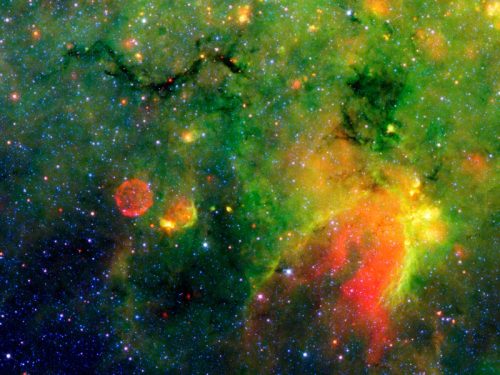Above: A false-color, infrared image of a dark cloud as seen against the bright background of Milky Way emission. Within the snake-like cloud structure seen here, dust and gas are congealing into new stars that are detected as embedded, hot cores.
The earliest stages in the life of a star are among the most mysterious. This is primarily because stars form inside dark clouds of material that block optical light, and because they form relatively quickly, in only hundred of thousands of years, whereas once a star starts burning its hydrogen fuel it can last for billions of years.
The details of high mass star birth are the most difficult of all to unravel because massive stars evolve the fastest, and can reach maturity even before their natal birth cloud dissipates. As a result, astronomers infer their presence from hot cores buried deep inside dark clouds, perhaps accompanied by other signposts like outflowing gas or strong ultraviolet radiation.
Infrared dark clouds are rich in molecules and dense gas. They are natural sites for star birth, and the hot cores inside them are thought to be among the earliest stellar embryos. CfA astronomers used the Smithsonian’s Submillimeter Array (SMA) to examine two hot cores that were previously discovered in infrared surveys and then confirmed as cores at millimeter wavelengths.
The SMA observations revealed the presence of over a dozen complex molecules including complex nitrogen-, oxygen-, and sulfur-rich species and isotopes of these molecules. The scientists model the data to conclude that the masses of the two cores are about eight and twenty-six solar-masses, that the temperatures in the material near these young stars are a few hundred kelvin, and that there is evidence for rotating structures (possibly preplanetary disks) around the young stars.
Source: Harvard.edu

No comments:
Post a Comment